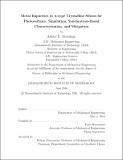| dc.contributor.advisor | Tonio Buonassisi. | en_US |
| dc.contributor.author | Morishige, Ashley E. (Ashley Elizabeth) | en_US |
| dc.contributor.other | Massachusetts Institute of Technology. Department of Mechanical Engineering. | en_US |
| dc.date.accessioned | 2016-09-13T18:08:13Z | |
| dc.date.available | 2016-09-13T18:08:13Z | |
| dc.date.copyright | 2016 | en_US |
| dc.date.issued | 2016 | en_US |
| dc.identifier.uri | http://hdl.handle.net/1721.1/104131 | |
| dc.description | Thesis: Ph. D., Massachusetts Institute of Technology, Department of Mechanical Engineering, 2016. | en_US |
| dc.description | This electronic version was submitted by the student author. The certified thesis is available in the Institute Archives and Special Collections. | en_US |
| dc.description | Cataloged from student-submitted PDF version of thesis. | en_US |
| dc.description | Includes bibliographical references (pages 193-211). | en_US |
| dc.description.abstract | Crystalline silicon is the dominant technology in the rapidly-growing photovoltaics (PV) industry, but significant cost reduction is still required before widespread grid parity is achieved. One-quarter of the cost of a PV module is the Si wafer. One way to reduce the cost/kWh of PV is to identify a higher-efficiency "drop-in" substitute for the currently dominant p-type multicrystalline silicon (mc-Si) wafer. This thesis explores one class of wafer substitute: n-type silicon. This material is thought to have higher defect tolerance than p-type, but practical mc-Si cell efficiencies have remained lower than in p-type. This thesis explores why, using a combination of simulation and experiment. In particular, synchrotron-based micro-X-ray fluorescence mapping is used to non-destructively evaluate metal impurity evolution during processing. This thesis demonstrates that metal impurity redistribution during solar cell processing is similar in n- and p-type mc-Si but the relative electrical impact of point defect and precipitated impurities is different, requiring different approaches to processing. It has been hypothesized and shown indirectly that metal impurities redistribute similarly in n- and p-type mc-Si during processing. To confirm this hypothesis, I combined Fermi-level analysis with direct measurements of the metal distribution before and after an industrially-relevant range of gettering processes. This study confirmed that the understanding of metal redistribution developed for p-type mc-Si is directly applicable to n-type mc-Si. To improve the understanding of metal impurity movement during solar cell processing, I developed a tool using Sentaurus TCAD software to visualize in 2D metal redistribution and the resulting recombination activity. I also performed an analytical review of the state of the art of crystalline silicon solar cell process simulation tools. The analysis elucidated the key physics of impurity gettering during solar cell processing and enabled guidelines for efficient, yet accurate, solar cell process simulations. To quantify the recombination activity of precipitated iron in n-type crystalline silicon, I directly measured the iron content and recombination strength of iron precipitates in n-type crystalline silicon using a suite of micro-characterization tools. I found that iron-containing precipitates are highly recombination active in n-type Si and that the precipitate size is correlated with its recombination strength. To enable this study, I benchmarked the use of a new high-throughput synchrotron-based data collection mode called on-the-fly scanning. To bring the level of sophistication of predictive simulation for p-type mc-Si to that of n-type mc-Si, I developed a simulation tool that calculates the redistribution of iron throughout the solar cell process and the resulting injection-dependent electrical performance of the wafer for both p- and n-type Si. Analysis using this tool indicates that p-type mc-Si usually requires point defect remediation during a slow cooling process, but for n-type mc-Si, dissolving iron-rich precipitates during shorter, higher temperature processing is often sufficient. Efficiency entitlement curves predict that n-type mc-Si can support 20% efficient solar cells. Finally, knowledge of defects developed for Si wafers was applied to a key challenge facing the PV industry at the PV system level. In the field, degradation of next-generation industrial p-type mc-Si PV modules has been observed. Leveraging the fundamental understanding of the physics of impurities in Si wafers, the recombination parameters of the root-cause defect were quantified. Building on the rich literature of p-type multicrystalline silicon, this thesis enables predictive engineering of all crystalline silicon materials from wafer growth to module performance in the field. | en_US |
| dc.description.statementofresponsibility | by Ashley E. Morishige. | en_US |
| dc.format.extent | 211 pages | en_US |
| dc.language.iso | eng | en_US |
| dc.publisher | Massachusetts Institute of Technology | en_US |
| dc.rights | M.I.T. theses are protected by copyright. They may be viewed from this source for any purpose, but reproduction or distribution in any format is prohibited without written permission. See provided URL for inquiries about permission. | en_US |
| dc.rights.uri | http://dspace.mit.edu/handle/1721.1/7582 | en_US |
| dc.subject | Mechanical Engineering. | en_US |
| dc.title | Metal impurities in n-type crystalline silicon for photovoltaics : simulation, synchrotron-based characterization, and mitigation | en_US |
| dc.type | Thesis | en_US |
| dc.description.degree | Ph. D. | en_US |
| dc.contributor.department | Massachusetts Institute of Technology. Department of Mechanical Engineering | |
| dc.identifier.oclc | 958149034 | en_US |
